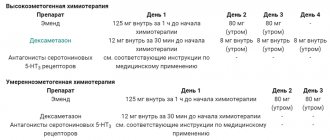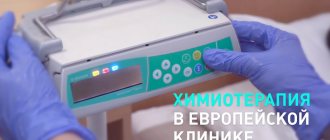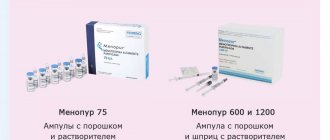Immunoro kedrion 300 mcg N1 lyophilisate for solution preparation
Release form
Lyophilisate for preparing a solution for intramuscular administration, white or light yellow; solvent - a clear, colorless liquid; the prepared solution is opalescent, colorless or light yellow.
Package
Glass bottles (1) complete with solvent (amp. 2 ml 1 pc.) - cardboard packs.
pharmachologic effect
Immunoglobulin. The active component of the drug is specific antibodies against the Rh0(D) antigen of human erythrocytes. The drug prevents isoimmunization in a Rh-negative woman’s body, as a result of the entry of fetal blood into the mother’s bloodstream at the birth of a Rh-positive child, during spontaneous and induced abortions, in the case of amniocentesis, or in the event of injury to the abdominal organs during pregnancy.
Anti-D immunoglobulins are polyclonal immunoglobulins, the mechanism of action of which is to neutralize Rh0(D) antigens present in the Rh-positive blood of the embryo. The period of effective action of the drug ranges from 48 to 144 hours on average, with the highest concentration of human anti-rhesus immunoglobulin Rh0(D) being achieved on average 56 hours after administration of the drug.
The drug is an immunologically active protein fraction isolated from virus-inactivated human plasma, tested for the absence of antibodies to human immunodeficiency viruses (HIV-1, HIV-2), hepatitis C virus and hepatitis B virus surface antigen.
Indications
- prevention of anti-D (Rh0) immunization in Rh-negative women (Rh0(D)), not sensitized to the Rh0(D) antigen, and in women with weakly positive Rh blood (Du), during pregnancy and birth of Rhesus -positive child. The drug is used for artificial and spontaneous termination of pregnancy in Rh-negative women who are not sensitized to the Rh0(D) antigen, in the case of Rh-positive blood of the father, as well as for amniocentesis, external rotation on the head, trauma to the abdominal organs, prenatal hemorrhage , ectopic pregnancy and chorionic villus sampling;
- prevention of anti-D (Rh0) immunization in Rh-negative patients after incompatible transfusion of Rh-positive blood or red blood cell concentrates.
Contraindications
- hypersensitivity to the components of the drug;
- Rh-positive and Rh-negative women sensitized to the Rh0(D) antigen, in whose blood serum Rh antibodies are detected;
- newborns.
Use during pregnancy and breastfeeding
This drug is used during pregnancy and for 72 hours after birth. No harmful effects on the course of pregnancy, the fetus or the newborn were noted.
special instructions
The drug should not be administered intravenously due to the possibility of shock. The injection should be intramuscular. To avoid the drug getting into the blood vessels, before starting to administer the drug, pull the syringe plunger towards you and check if there is any blood in the syringe. True allergic reactions to intramuscularly administered human anti-rhesus immunoglobulin Rh0(D) are rare. When the first symptoms of anaphylactoid reactions appear, anti-shock therapy is carried out using antihistamines, alpha-adrenergic agonists and corticosteroids.
Immunoglobulin intolerance occurs in very rare cases of immunoglobulin A (IgA) deficiency when the patient has antibodies against IgA.
Monitoring the patient continues for 30-60 minutes after the injection. Administration of the drug is stopped immediately if an allergic or anaphylactic reaction is suspected. If shock develops, antishock therapy is used.
After the administration of immunoglobulin, a passive increase in the level of antibodies in the patient’s blood may be observed, which can lead to an erroneous false-positive interpretation of the results of serological testing. The administration of human anti-Rhesus immunoglobulin Rh0(D) significantly affects the results of tests such as the determination of antibodies and blood group, including the Coombs test and the antiglobulin test.
Virus safety. When producing medicines from human blood or plasma, a set of measures is used to prevent possible transmission of infection to patients. These measures include careful selection of healthy donors, ensuring that there is no risk of infectious contamination of donors, as well as monitoring the blood of each donor and the general plasma pool for the absence of viruses and infections. Each unit of plasma used for the manufacture of the drug is tested for the absence of surface antigen of the hepatitis B virus and antibodies to human immunodeficiency viruses (HIV-1, 2), to the hepatitis C virus. Each pool of plasma is also monitored for the absence of hepatitis C virus RNA using the polymerase method chain reaction. For the manufacture of the drug, only plasma is used that gives negative results for all of the above tests. The production of human blood products also includes manufacturing steps in human blood or plasma to inactivate or remove viruses. Despite this, when using medicinal products made from human blood or plasma, the possibility of transmission of infection, including unknown or new viruses and other infectious agents, cannot be completely excluded.
Compound
human plasma proteins (containing at least 90% immunoglobulins) 25-180 mg,
incl. human immunoglobulin anti-Rhesus Rh0(D) 150 mcg (750 IU)
Excipients: glycine, sodium chloride.
Solvent: water for injection (up to 1 ml).
Directions for use and doses
The drug solution is administered intramuscularly.
Postpartum prevention. 1000-1500 IU (200-300 mcg) is recommended as the optimal standard dose without prior testing for maternal fetal hemoglobin (HbF) infiltration using the Kleihauer-Betke method. The drug is administered to the mother as soon as possible after birth, but no later than 72 hours.
Prenatal and postnatal prevention. The first dose is 1000-1500 IU (200-300 mcg) at the 28th week of pregnancy. The next dose of 1000-1500 IU (200 - 300 mcg) is administered within 72 hours after birth if the child was born Rh-positive.
After termination of pregnancy, ectopic pregnancy or hydatidiform mole. During the first 72 hours after the intervention, the drug is administered at a dose of 600-750 IU (120-150 mcg) until the 12th week of pregnancy; 1250-1500 IU (250-300 mcg) after 12 weeks of pregnancy; 1250-1500 IU (250-300 mcg) after amniocentesis or chorionic villus sampling.
After incompatible transfusion of Rh-positive blood. 500 IU-1250 IU (100-250 mcg) for every 10 ml of blood transfused for several days.
In the case of pathology of the coagulation system, when intramuscular administration of drugs is contraindicated, human anti-rhesus immunoglobulin Rh0(D) can be administered subcutaneously. After the injection, a compress is carefully applied to the injection site.
If a large total dose is required (more than 5 ml), it is recommended that it be divided into smaller doses and injected into different locations.
Preparation and administration of the drug solution
The bottle with the drug lyophilisate and the ampoule with the solvent should be warmed to room temperature or body temperature. Draw up the contents of the ampoule with solvent into an injection syringe, remove the protective cap from the rubber stopper of the bottle with lyophilisate and slowly introduce the solvent into the bottle; gently shake the bottle with the solution or hold until the lyophilisate is completely dissolved; draw the solution into a syringe; change the needle and inject.
Incomplete dissolution of the lyophilisate leads to loss of activity of the drug. Do not use if solution is cloudy or contains sediment. The lyophilisate from an opened bottle must be reconstituted and used immediately. The remains of the drug must be destroyed.
Side effects
Local reactions:
pain at the injection site. This can be avoided by injecting a large volume of solution in several doses of less than 5 ml in several different places.
Systemic reactions:
uncommon - fever, skin reactions, chills; rarely - dyspeptic symptoms (nausea and vomiting), decreased blood pressure, tachycardia, allergic or anaphylactic reactions.
Storage conditions
The drug should be stored out of the reach of children and protected from light at a temperature not exceeding 25°C. Do not freeze.
Best before date
3 years.
Immunoro Kedrion lyophilic solution d/i.m. injected 300 µg vial No. 1
Compound
| 1 ml of ready-made solution | |
| human plasma proteins (containing at least 90% immunoglobulins) | 25-180 mg, |
| incl. human immunoglobulin anti-rhesus Rh0(D) | 150 mcg (750 IU) |
Excipients: glycine, sodium chloride. Solvent: water for injection (up to 1 ml).
Pharmacokinetics
The detectable antibody concentration is achieved in the blood approximately 20 minutes after the intramuscular injection of the drug. Cmax of antibodies in blood plasma is usually achieved 2-3 days after injection.
T1/2 of human anti-rhesus immunoglobulin Rh0(D) is individual, equal to that of normal human immunoglobulin and is 3-4 weeks. Immunoglobulin and its complexes are destroyed in the cells of the reticuloendothelial system.
Indications for use
- prevention of anti-D (Rh0) immunization in Rh-negative women (Rh0(D)), not sensitized to the Rh0(D) antigen, and in women with weakly positive Rh blood (Du), during pregnancy and birth of Rh- positive child. The drug is used for artificial and spontaneous termination of pregnancy in Rh-negative women who are not sensitized to the Rh0(D) antigen, in the case of Rh-positive blood of the father, as well as for amniocentesis, external rotation on the head, trauma to the abdominal organs, prenatal hemorrhage , ectopic pregnancy and chorionic villus sampling;
- prophylaxis of anti-D (Rh0) immunization in Rh-negative patients after incompatible transfusion of Rh-positive blood or red blood cell concentrates.
Contraindications
- hypersensitivity to the components of the drug;
- Rh-positive and Rh-negative women sensitized to the Rh0(D) antigen, in whose blood serum Rh antibodies are detected;
- newborns.
Directions for use and doses
The drug solution is administered intramuscularly.
Postpartum prevention. 1000-1500 IU (200-300 mcg) is recommended as the optimal standard dose without prior testing for maternal fetal hemoglobin (HbF) infiltration using the Kleihauer-Betke method. The drug is administered to the mother as soon as possible after birth, but no later than 72 hours.
Prenatal and postnatal prevention. The first dose is 1000-1500 IU (200-300 mcg) at the 28th week of pregnancy. The next dose of 1000-1500 IU (200 - 300 mcg) is administered within 72 hours after birth if the child was born Rh-positive.
After termination of pregnancy, ectopic pregnancy or hydatidiform mole. During the first 72 hours after the intervention, the drug is administered at a dose of 600-750 IU (120-150 mcg) until the 12th week of pregnancy; 1250-1500 IU (250-300 mcg) after 12 weeks of pregnancy; 1250-1500 IU (250-300 mcg) after amniocentesis or chorionic villus sampling.
After incompatible transfusion of Rh-positive blood. 500 IU-1250 IU (100-250 mcg) for every 10 ml of blood transfused for several days.
In the case of pathology of the coagulation system, when intramuscular administration of drugs is contraindicated, human anti-rhesus immunoglobulin Rh0(D) can be administered subcutaneously. After the injection, a compress is carefully applied to the injection site.
If a large total dose is required (more than 5 ml), it is recommended that it be divided into smaller doses and injected into different locations.
Preparation and administration of the drug solution
The bottle with the drug lyophilisate and the ampoule with the solvent should be warmed to room temperature or body temperature. Draw up the contents of the ampoule with solvent into an injection syringe, remove the protective cap from the rubber stopper of the bottle with lyophilisate and slowly introduce the solvent into the bottle; gently shake the bottle with the solution or hold until the lyophilisate is completely dissolved; draw the solution into a syringe; change the needle and inject.
Incomplete dissolution of the lyophilisate leads to loss of activity of the drug. Do not use if solution is cloudy or contains sediment. The lyophilisate from an opened bottle must be reconstituted and used immediately. The remains of the drug must be destroyed.
Storage conditions
The drug should be stored out of the reach of children and protected from light at a temperature not exceeding 25°C. Do not freeze.
Best before date
3 years. Do not use the drug after the expiration date.
special instructions
The drug should not be administered intravenously due to the possibility of shock. The injection should be intramuscular. To avoid the drug getting into the blood vessels, before starting to administer the drug, pull the syringe plunger towards you and check if there is any blood in the syringe. True allergic reactions to intramuscularly administered human anti-rhesus immunoglobulin Rh0(D) are rare. When the first symptoms of anaphylactoid reactions appear, anti-shock therapy is carried out using antihistamines, alpha-adrenergic agonists and corticosteroids.
Immunoglobulin intolerance occurs in very rare cases of immunoglobulin A (IgA) deficiency when the patient has antibodies against IgA.
Monitoring the patient continues for 30-60 minutes after the injection. Administration of the drug is stopped immediately if an allergic or anaphylactic reaction is suspected. If shock develops, antishock therapy is used.
After the administration of immunoglobulin, a passive increase in the level of antibodies in the patient’s blood may be observed, which can lead to an erroneous false-positive interpretation of the results of serological testing. The administration of human anti-Rhesus immunoglobulin Rh0(D) significantly affects the results of tests such as the determination of antibodies and blood group, including the Coombs test and the antiglobulin test.
Virus safety. When producing medicines from human blood or plasma, a set of measures is used to prevent possible transmission of infection to patients. These measures include careful selection of healthy donors, ensuring that there is no risk of infectious contamination of donors, as well as monitoring the blood of each donor and the general plasma pool for the absence of viruses and infections. Each unit of plasma used for the manufacture of the drug is tested for the absence of surface antigen of the hepatitis B virus and antibodies to human immunodeficiency viruses (HIV-1, 2), to the hepatitis C virus. Each pool of plasma is also monitored for the absence of hepatitis C virus RNA using the polymerase method chain reaction. For the manufacture of the drug, only plasma is used that gives negative results for all of the above tests. The production of human blood products also includes manufacturing steps in human blood or plasma to inactivate or remove viruses. Despite this, when using medicinal products made from human blood or plasma, the possibility of transmission of infection, including unknown or new viruses and other infectious agents, cannot be completely excluded.
Description
A drug for the prevention of Rh conflict. Specific immunoglobulin.
Dosage form
Lyophilisate for preparing a solution for intramuscular administration, white or light yellow; solvent - a clear, colorless liquid; the prepared solution is opalescent, colorless or light yellow.
Use in children
The drug should not be administered to newborns.
Action
Immunoglobulin. The active component of the drug is specific antibodies against the Rh0(D) antigen of human erythrocytes. The drug prevents isoimmunization in a Rh-negative woman’s body, as a result of the entry of fetal blood into the mother’s bloodstream at the birth of a Rh-positive child, during spontaneous and induced abortions, in the case of amniocentesis, or in the event of injury to the abdominal organs during pregnancy.
Anti-D immunoglobulins are polyclonal immunoglobulins, the mechanism of action of which is to neutralize Rh0(D) antigens present in the Rh-positive blood of the embryo. The period of effective action of the drug ranges from 48 to 144 hours on average, with the highest concentration of human anti-rhesus immunoglobulin Rh0(D) being achieved on average 56 hours after administration of the drug.
The drug is an immunologically active protein fraction isolated from virus-inactivated human plasma, tested for the absence of antibodies to human immunodeficiency viruses (HIV-1, HIV-2), hepatitis C virus and hepatitis B virus surface antigen.
Side effects
Local reactions: pain at the injection site. This can be avoided by injecting a large volume of solution in several doses of less than 5 ml in several different places.
Systemic reactions: infrequently - fever, skin reactions, chills; rarely - dyspeptic symptoms (nausea and vomiting), decreased blood pressure, tachycardia, allergic or anaphylactic reactions.
Use during pregnancy and breastfeeding
This drug is used during pregnancy and for 72 hours after birth. No harmful effects on the course of pregnancy, the fetus or the newborn were noted.
Interaction
Human anti-rhesus immunoglobulin Rh0(D) cannot be mixed with other drugs.
Reduces the activity of attenuated live vaccines against measles, rubella, mumps, and chickenpox for a period of up to 3 months.
Overdose
No cases of overdose have been reported.




